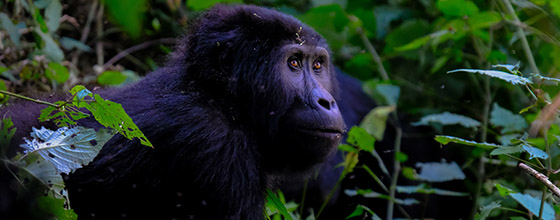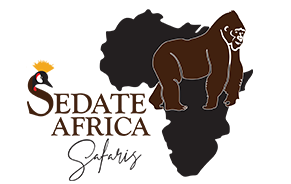
Mgahinga National Park Aka Home of Silver and Gold
Uganda Wildlife Tours| Uganda Gorilla Trekking | Uganda Golden Monkey
Uganda’s smallest park (33.7km²) protects mountain gorillas and other fauna on the Ugandan slopes of the Virunga volcanoes. Though small in size, Mgahinga contains a dramatic, panoramic backdrop formed by three volcanoes Mgahinga has one habituated gorilla group. Mgahinga Gorilla National Park covers the slopes of Muhuvura, Gahinga and Sabinyo at an altitude of between 2,227m near Ntebeko Park HQ and 4,127m on the summit of Mt. Muhuvura. Though small in size, just 33.7km², it adjoins Volcanoes NP in Rwanda and Virunga NP in Congo. Collectively, these three parks form the transboundary Virunga Conservation Area (VCA). The most famous inhabitant of Mgahinga and the VCA is the endangered mountain gorilla. Gorilla conservation on the Virungas dates back to 1925 when the Belgians gazetted the portion of the range in present day Congo and Rwanda as a national park to protect mountain gorillas. The British administration declared the
Ugandan section as a game sanctuary in 1930. This was upgraded to national park status in 1991. Mgahinga’s three volcanoes provide a dramatic and distinctive backdrop to regional scenery and each has been named descriptively in the local language. Gahinga is the smallest of the Virunga peaks and its name means ‘small pile of stones;’ a comparison with the cairns piled by local farmers when clearing boulderstrewn land. The lofty Muhuvura is an important landmark and its name means ‘the guide,’ while that of the distinctive Mt. Sabinyo, with its rough, jagged crown, translates as ‘old man’s teeth.’
Wildlife
Mgahinga Gorilla NP is home to 76 mammal species, of which the best known is the mountain gorilla. Roughly half of the total population (780) of this endangered ape lives on the Virungas and half in nearby Bwindi Impenetrable NP. The bamboo zone in Mgahinga is also home to another endangered primate, the golden monkey which occurs only in the bamboo forests of the Virungas. Other large mammals include elephant, buffalo, leopard and giant forest hog though these are rarely encountered in the dense forest. Though the park’s birdlist currently stands at just 115 species, this includes many localized forest birds and Albertine Rift endemics, including the striking Rwenzori turaco.
Local People
Historically, the forests of Mgahinga were home to Batwa Pygmies whose hunter-gatherer lifestyle predates all other human activities in the region. In recent centuries, the area has been cleared and settled by Bafumbira farmers who cultivate up to the edge of the remnant forest protected within the national park.
Access
Roads
Mgahinga Gorilla National Park is 524km from Kampala. A surfaced highway runs via Mbarara and Kabale to Kisoro. The 80km road between Kabale and Kisoro is a winding drive through mountainous terrain with steep ascents and descents. Beyond Kisoro, a rough, 14km road with steep, rocky sections ascends to the park headquarters at Ntebeko.
By Air
Mgahinga can also be reached by daily flights from Entebbe International Airport to Kisoro airfield.
Climate
Daytime temperatures average around 150C, with nights dropping to a cool 100C. There are two dry seasons, December-February and May-August, with June and July being the driest months. The wettest months are March-April and September-November. During the rains, the park is often covered in mist and the air is always damp.
When to Visit
All year round.
OUTSIDE THE PARK
Lake Bunyonyi
When volcanic craters blocked the Ruhuma Valley west of Kabale town, the result was Lake Bunyonyi, Africa’s second deepest lake. Crammed with at least 20 small islands and encircled by steep terraced hills, it is unforgettably pretty and is a perfect spot to break the journey on the way to Mgahinga.
Lake Mutanda
Another consequence of a volcanic dam, Lake Mutanda lies 15km north of Mgahinga. A cluster of resorts on the northern shore, 16km from Kisoro enjoy a fabulous view across the island-dotted waters towards the Virunga volcanoes.
Ntebeko visitor centre
The Visitor Centre at Ntebeko is the trailhead for nature walks, volcano climbs, and golden monkey and gorilla tracking. Exhibits inside the building explore themes relating to the Virunga environment. A trail along the adjacent drystone Buffalo Wall (built to keep animals out of neighboring farmland) provides good birding and views of the park’s dramatic volcanic backdrop.
Gorilla tracking
Following a trail of trampled and snapped vegetation across the slopes of the Virungas to spend an hour in the company of mountain gorillas ranks among the world’s most sought after wildlife encounters. Gorilla tracking starts daily at 0800 at the Ntebeko Visitor Centre and typically lasts 3-5 hours. Permits must be booked in advance through the UWA Booking Office in Kampala.
Gorilla rules
To protect the gorillas and visitors, rules and guidelines have been set and must be adhered to. Ensure you get a copy of these rules from the reservations office or at the park. Note that visitors participating in gorilla tracking must be aged 15 or over.
Golden monkey tracking
Though the gorillas hog the limelight, they are not the only endangered primates on the Virungas. The volcanoes are the last viable stronghold of the golden monkey which can be tracked through its bamboo habitat on the slopes of Mt. Gahinga. As with gorillas, contact time with this rare Albertine rift endemic is limited to an hour. Visitors who sign up for the habituation experience, however, can spend all day following this striking orange-coated monkey in the company of researchers.
Volcano climbing
Mgahinga Gorilla NP rises upwards to three of the Virunga’s six volcanic summits, all of which can be climbed in a day. Views from the peaks – into Rwanda and Congo, and towards the rift valley and Bwindi Impenetrable Forest – more than justify the effort. The park’s highest peak is Muhavura. Its 4,127m summit is adorned by a crystal clear crater lake, 40m in diameter, and commands panoramic views along the length of the Virunga chain. Muhuvura is the only mountain in SW Uganda to display the full range of altitudinal vegetation zones peculiar to East Africa’s highest mountains. The hike to the top passes through montane forest, bamboo stands and heather groves, before encountering bizarre forms of giant lobelias and groundsels at the summit. Mount Gahinga (3,474m) is the smallest of the Virunga volcanoes and its bamboo-covered slopes rise up to a lush, swamp-filled crater, about 180m wide. The jagged crown of Sabinyo (3,669m) bears several summits divided by deep gorges and ravines. Some steep and vertiginous sections, including an ascent of a fixed ladder, must be negotiated to reach the summit and enjoy the rare privilege of standing 3,669m high whilst in 3 countries at once.
Birding
Keen birders can seek rare Albertine Rift endemics and other forest birds in a range of scenic locations that include the Sabinyo Gorge (prime habitat for the beautiful Rwenzori Turaco), the saddle between Mounts Gahinga and Sabinyo, and the Boundary Trail at Ntebeko, with its incomparable volcanic backdrop.
The Batwa trail
For generations, Mgahinga’s dense forests were home to the indigenous Batwa Pygmies, hunter-gatherers and warriors, who depended on the forest for shelter, food and medicine. Today, Batwa guides lead visitors through the lower slopes of the forests, introducing them to their old home and demonstrating the skills they used to survive in it. The highlight of the Batwa Trail is the descent into the Garama Cave, the largest of numerous lava tubes with which the slopes of the Virungas are riddled. Once the home of the Batwa king, this is the setting for the finale to the Batwa Trail; a memorable subterranean performance of music and dance. Full and half day trails are available.
